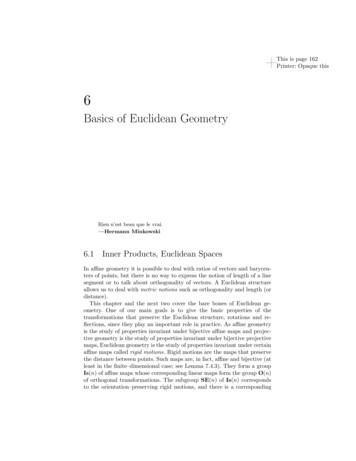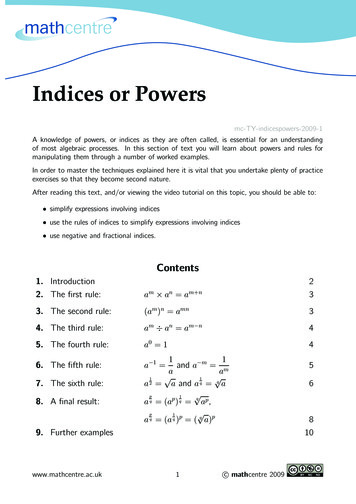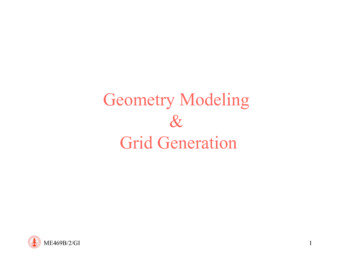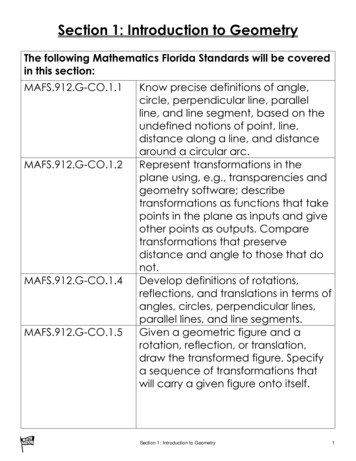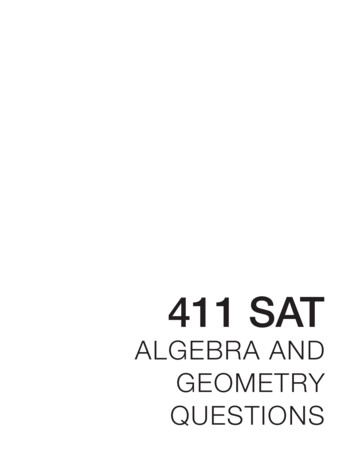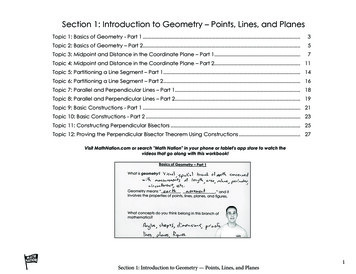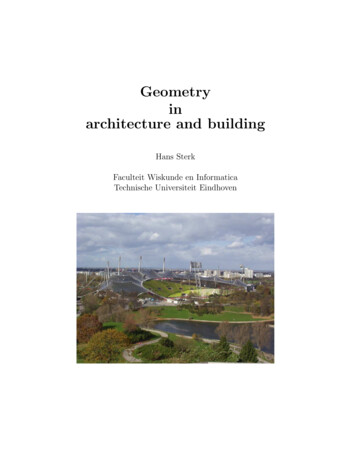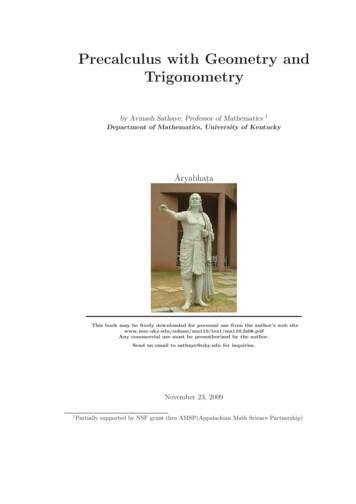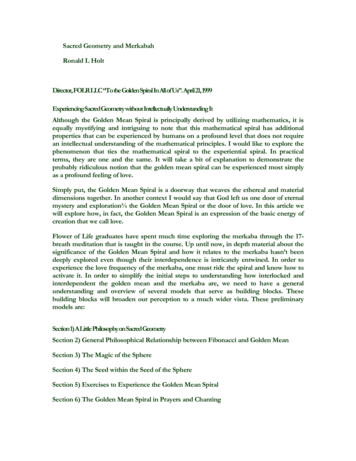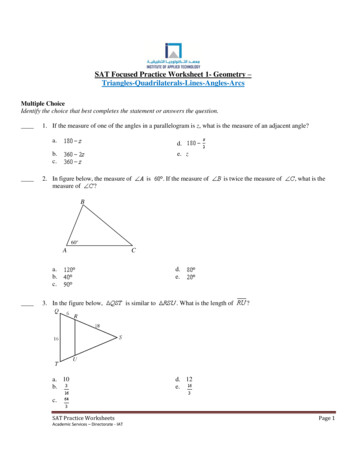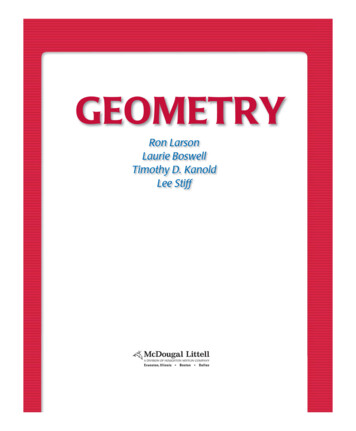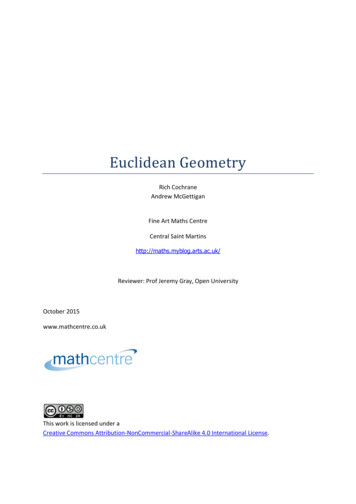
Transcription
Euclidean GeometryRich CochraneAndrew McGettiganFine Art Maths CentreCentral Saint Martinshttp://maths.myblog.arts.ac.uk/Reviewer: Prof Jeremy Gray, Open UniversityOctober 2015www.mathcentre.co.ukThis work is licensed under aCreative Commons Attribution-NonCommercial-ShareAlike 4.0 International License.
2ContentsIntroduction5What's in this Booklet?5To the Student6To the Teacher7Toolkit7On Geogebra8Acknowledgements10Background Material11The Importance of MethodFirst Session: Tools, Methods, Attitudes & Goals1215What is a Construction?15A Note on Lines16Copy a Line segment & Draw a Circle17Equilateral Triangle23Perpendicular Bisector24Angle Bisector25Angle Made by Lines26The Regular Hexagon27www.mathcentre.co.uk Rich Cochrane & Andrew McGettiganCentral Saint Martins, UALReviewer: Jeremy GrayOpen University
3Second Session: Parallel and Perpendicular30Addition & Subtraction of Lengths30Addition & Subtraction of Angles33Perpendicular Lines35Parallel Lines39Parallel Lines & Angles42Constructing Parallel Lines44Squares & Other Parallelograms44Division of a Line Segment into Several Parts50Thales' Theorem52Third Session: Making Sense of Area53Congruence, Measurement & Area53Zero, One & Two Dimensions54Congruent Triangles54Triangles & Parallelograms56Quadrature58Pythagoras' Theorem58A Quadrature Construction64Summing the Areas of Squares67Fourth Session: Tilings69The Idea of a Tiling69Euclidean & Related Tilings69Islamic Tilings73Further Tilings74www.mathcentre.co.uk Rich Cochrane & Andrew McGettiganCentral Saint Martins, UALReviewer: Jeremy GrayOpen University
4Fifth Session: Square Roots, Spirals and the Golden Ratio76The Idea of a Square Root76The Spiral of Theodorus78The Golden Rectangle & Spiral79Solving the Equation by Construction86Geometry as Algebra88Sixth Session: Constructability89Construction of the Pentagon89Which Regular Polygons can we Construct?96Online Resources99Bibliography101www.mathcentre.co.uk Rich Cochrane & Andrew McGettiganCentral Saint Martins, UALReviewer: Jeremy GrayOpen University
5IntroductionAs part of the work of the sigma-funded Fine Art Maths Centre at Central Saint Martins, we havedevised a series of geometry workshop courses that make little or no demands as to prerequisitesand which are, in most cases, led by practical construction rather than calculation. This booklet andits accompanying resources on Euclidean Geometry represent the first FAMC course to be 'writtenup'.We have taught the material in a Fine Art setting, but it could be adapted with little difficulty forDesign or Arts and Humanities students; some of it was first tried out in public “drop-in” sessions weran out of a pub and later a café from 2012 to2014. Our approach is also suitable for those who maypreviously have had bad experiences with mathematics: algebra and equations are kept to aminimum and could be eliminated.If you’re a maths teacher interested in reaching students whose main interests are artistic, culturalor philosophical we hope you’ll find something of value here whether you run the course “as is” oradapt it heavily to suit your own students. Many of the students who follow this one go on to ourcourse Perspective & the Geometry of Vision, although it is not a prerequisite.If you’re a student we hope there’s enough information here and in the online resources to get youstarted with Euclidean geometry. Learning almost anything is easier with a good instructor butsometimes we must manage on our own. This book does contain “spoilers” in the form of solutionsto problems that are often presented directly after the problems themselves – if possible, try tofigure out each problem on your own before peeking.We’re aware that Euclidean geometry isn’t a standard part of a mathematics degree, much less anyother undergraduate programme, so instructors may need to be reminded about some of thematerial here, or indeed to learn it for the first time. We’ve therefore addressed most of ourremarks to an intelligent, curious reader who is unfamiliar with the subject.Experts will, of course, find they can skim over parts that neophytes may need to take slowly.Likewise, some of our remarks are obviously directed to teachers and few of the more wide-reachingexamples are boxed off: those with limited mathematical background can safely ignore them.We assume that students following the course have no formal mathematical training beyond basicarithmetic. The level of prior maths study seems, in our experience, to be a fairly poor predictor ofhow well a student will cope with their first meeting with Euclidean geometry. Our aim is not tosend students away with a large repertoire of theorems, proofs or techniques. Instead we focuspersistently on what we think are the important general ideas and skills. In particular, theconstruction and understanding of careful proofs is given centre stage.What’s in this Booklet?We begin with some remarks connecting our subject with areas that arts and humanities studentsprobably know about and are interested in. Partly this makes for good motivation, and helps thesubject seem less like a “maths course” that stands apart from everything else they’re doing; afterall, we know it’s pedagogically better to connect new learning with prior knowledge and expertise.We would also like to grind our own axe a little here: mathematics can be considered an arts orwww.mathcentre.co.uk Rich Cochrane & Andrew McGettiganCentral Saint Martins, UALReviewer: Jeremy GrayOpen University
6humanities subject in itself, and its close connections with philosophy and cultural production testifyto that. We’ve included some contentious points that should spark debate.We then outline six “sessions”. When we run the course these are usually run as discrete, two-hourweekly lessons. We cover much of the same material in an extra-mural class “Geometry ThroughDrawing” in two intensive days. There’s more here than we ever cover in a single presentation ineither format, so choices must be made based on the students’ and presenters’ priorities.We end with an annotated bibliography and a list of online resources.This booklet and its sister, Perspective and the Geometry of Vision, were made possible by agenerous grant from sigma, the network for excellence in mathematics and statistics support.www.sigma-network.ac.ukTo the StudentMathematics isn’t quite like any other subject you may have studied before. What’s more, studyingthis kind of maths probably isn’t going to be similar to the experience you may have had with thesubject at school. A short course is, we hope, just the beginning of a long-term process of absorbing,struggling with and thinking about mathematical ideas. Like Sophie Germain, a self-taught Frenchmathematician, you may have to do much of this on your own. Part of what a course like this can dois equip you, at least a little bit, for that journey.Studying maths at school is mostly about learning to pass a sequence of standardised tests as part ofa process of social initiation. Most mathematicians will admit that some useful skills are acquired inthe process, but many will also stress that the subject as it’s presented in school bears very littleresemblance to what excites them, or to what they do all day. Some very successful mathematiciansweren’t good at the subject at school. Often there’s a story about an inspiring teacher or book thatled the young student down an alternative path and gave them an insight into the “good stuff” thatmost teachers aren’t really supposed to spend the class’s time on. Euclidean geometry can be this“good stuff” if it strikes you in the right way at the right moment.Maths is a very odd activity. Here’s how Andrew Wiles, who proved Fermat’s Last Theorem,described the process:Perhaps I can best describe my experience of doing mathematics in terms of a journeythrough a dark unexplored mansion. You enter the first room of the mansion and it’scompletely dark. You stumble around bumping into the furniture, but gradually youlearn where each piece of furniture is. Finally after six months or so, you find the lightswitch, you turn it on, and suddenly it’s all illuminated. You can see exactly where youwere. Then you move into the next room and spend another six months in the dark.So each of these breakthroughs, while sometimes they’re momentary, sometimesover a period of a day or two, they are the culmination of—and couldn’t existwithout—the many months of stumbling around in the dark that precede them.(Quoted in William Byers, How Mathematicians Think, p. 1, and in many other places.)www.mathcentre.co.uk Rich Cochrane & Andrew McGettiganCentral Saint Martins, UALReviewer: Jeremy GrayOpen University
7The key thing is that the experience Wiles is describing is that most of the time you’re confused andlost. If it feels that way for him, you can expect it to feel that way for you too. Although the mathshe’s talking about is very high-powered, the process really does feel like that for most of us, at leastwhen we’re doing it right, even when we’re trying to learn something Wiles can do in his sleep.Don’t be misled by well-meaning people who say learning maths is a linear process that mustproceed in tiny steps, in a prescribed order, mastering each one before moving onto the next. Onthe contrary, we blunder around, confused, reading things out of sequence and going repeatedlyback to them, slowly forming a picture of what’s going on and how it connects to other things weknow. We try things – whenever we can at Central Saint Martins, we make or draw things! – andgradually the fog of confusion clears, until the thing that once seemed impossible to understandbecomes so obvious we’ve forgotten it was ever difficult.To the TeacherThe adjective “Euclidean” is supposed to conjure up an attitude or outlook rather than anythingmore specific: the course is not a course on the Elements but a wide-ranging and (we hope)interesting introduction to a selection of topics in synthetic plane geometry, with the construction ofthe regular pentagon taken as our culminating problem.We like to teach this material, as far as possible, through practical drawing, on the principle that aconstruction can be a perfectly good proof in itself. It isn’t usually necessary to supplement this byrunning through the same proof symbolically unless some students find it helps them understoodwhat they’ve been doing. There are a few proofs, such as Thales’ Theorem, that we do “on theboard” but we stress that in these cases that following the details of the proof is optional.Obviously, drawing and making are fun and can be hilariously difficult, which is all to the good. Whenwe say that students should figure something out for themselves, we almost always take this tomean working collaboratively in pairs or in whatever ad hoc groupings they like; occasionally astudent prefers to work alone, and that’s usually OK too. The middle two sessions are deliberately“lighter” and give students a chance to get used to the basic constructions.This requires some emphasis up-front on what a construction is and how it differs from, for example,a representative drawing or a diagram. It’s a good idea to have students explain the steps in theirconstruction when a particular problem has been solved. Having one student give instructions, orexplain their thinking, to another is often helpful.Arts and humanities students can be surprisingly challenging maths students. They often ask veryawkward questions or develop misunderstandings that are unexpected and rather profound. This iswhy we’ve taken time to explain some apparently simple matters in detail, especially in the earlysessions. Your maths and physics students probably won’t worry about what a circle is or whethertwo lines truly intersect at a single point, but your arts and humanities students might.ToolkitThe main activity in geometry class will be drawing, so we need some equipment. In fact, we won’tneed much: just a compass, a “straightedge”, some pencils and some blank paper. Large pads ofpaper are good – we like to use A2 although that can be a bit unwieldy to carry around. You can getwww.mathcentre.co.uk Rich Cochrane & Andrew McGettiganCentral Saint Martins, UALReviewer: Jeremy GrayOpen University
8started with any old school compass, a ruler, a pencil and a scrap of paper but a small investment inbetter tools makes the whole experience more pleasant.The compasses we use most often are Rotring Master Bow Compasses like the one pictured on theleft; they’re quite cheap and work well for most jobs. By spending a little more one can get the kindwith an extension bar that allows for bigger circles – helpful but not essential. It’s very useful to havea small compass for fiddly work, too. An attachment that will take a pen opens up some options forfinishing a drawing or bringing out important elements; only the very bravest will attempt to use abottle of ink and a ruling pen, though many compasses come with a suitable attachment.A “straightedge” just means any tool you can use to make a straight line. You may as well use a ruler,although we emphasise from the start that any markings on it (inches, centimetres and so on) are tobe ignored. We haven’t found an affordable supply of plain metal strips that are well-made enoughto provide a good edge: if we did we’d give those out at the start of the course. Metal is nice to workwith but plastic can be helpful when you want to be able to see underneath it as you work. Anordinary 30cm (1 foot) one is absolutely fine, although occasionally a 50cm one comes in handy forbigger drawings.As for pencils, constructions work best when they’re precise so sharpness is the most importantquality. Since harder pencils take and hold a sharp point better, we recommend having to handsome hard-ish pencils (roughly 3H) and a sharpener. Any pencil, though, will do at a pinch and thecommon HB ones are fine.You do not need any of the other things you may find in a “geomet
We’re aware that Euclidean geometry isn’t a standard part of a mathematics degree, much less any other undergraduate programme, so instructors may need to be reminded about some of the material here, or indeed to learn it for the first time. We’ve therefore addressed most of our remarks to an intelligent, curious reader who is unfamiliar with the subject. Experts will, of course, find .
